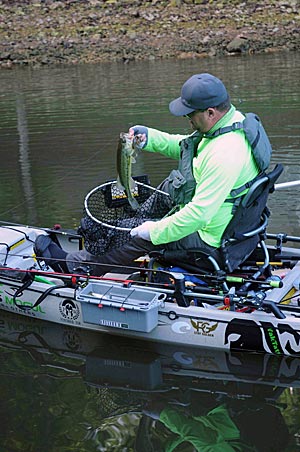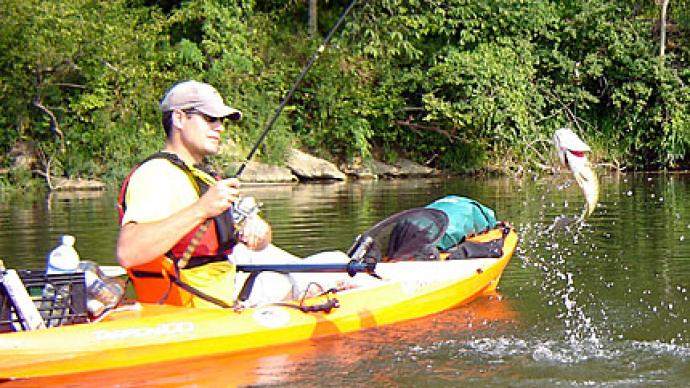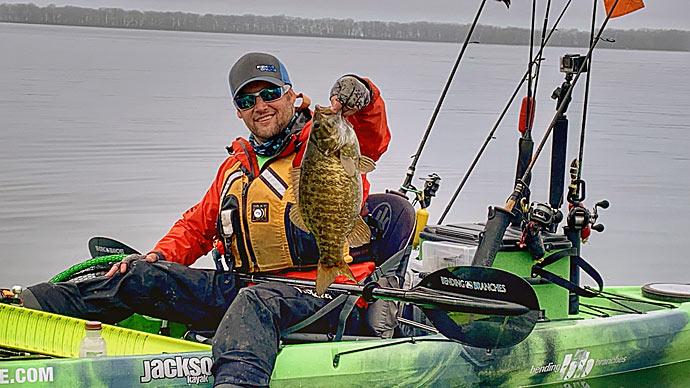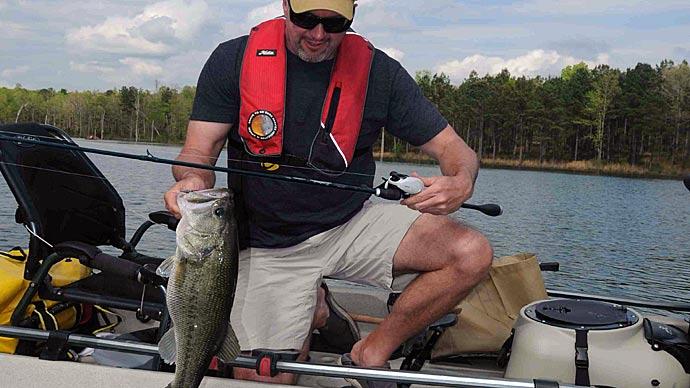
The growing popularity of kayak bass fishing has prompted some kayak anglers to expand their horizons.
Fishing kayaks were once considered the ideal boat for fishing on small remote waters, but kayak manufacturers are now building bigger and more stable boats that allow anglers to venture out safely on massive lakes and reservoirs throughout the country. The kayak tournament circuits also hold bass tournaments on big waters such as Kentucky Lake, Lake Erie, and Upper Chesapeake Bay.
Missouri angler Jeff Mellencamp competes in Mo-Yak Fishing Series bass tournaments on the large impoundments such as Lake of the Ozarks, Table Rock, and Bull Shoals. He offers the following tips on kayak bass fishing the big waters.
Get A Bigger Boat
The tournament angler suggests you need a kayak capable of handling waves created by other anglers in bass boats and recreational boaters. He ventures out on the big waters in a Hobie Pro Angler 14, which is 14 feet long. “It allows me to get on the big waters and handle the waves,” Mellencamp says. His kayak is also stable enough that he can stand up and fish.
Kayaks made by Hobie, Old Towne, and other manufacturers can be powered by paddle, pedal-drive systems, or trolling motors. Mellencamp’s Hobie features the MirageDrive system, a forward-reverse pedal propulsion system. “It makes it much more pleasant to fish, especially on big water,” Mellencamp says. He claims the pedal-drive system allows him to cruise at an average speed of 4 mph and a top speed of 6 mph. The Missouri angler says he has covered up to 12 miles in a day fishing from his kayak, but he has typically fished about 4 to 6 miles in a day.
The bigger kayak has a weight capacity of 600 pounds allowing Mellencamp to carry more tackle. “I usually carry about eight or nine rods with me,” he says. “I’ve also got a lot of tackle.”
The accessories available for today’s fishing kayaks can turn your big waters kayak into a miniature version of a bass boat. “You need a fish finder that will help you narrow down your search,” Mellencamp says. He previously used a Lowrance Hook2 on his kayak but now relies on a Garmin EchoMap 73cv chartplotter/sonar unit.
Other critical accessories for kayak bass fishing on big lakes include an anchoring system such as the Anchor Wizard for deep water or a Power-Pole Micro Anchor for fishing less than 8 feet deep.
Pick A Time and Location
Fishing on big waters offers kayak anglers more areas to fish than the smaller lakes and ponds. The big lakes feature plenty of public access areas or pay put-in ramps allowing kayak anglers to try main lake spots, coves, bays, and creeks or tributaries flowing into the lakes.
The summertime boat traffic on his home waters of Lake of the Ozarks makes it tough to fish from his kayak on the open water sections of the lake, so Mellencamp avoids the pleasure boaters by venturing up the creeks then. He fishes the wider open sections of the lake at night or early morning during the summer when recreational boat traffic is minimal.
Be Wary of Waves
Whereas kayak anglers on small waters only have to contend with waves created by wind, kayak anglers on the big lakes must also contend with large wakes from power boats. “I always pay attention to waves, and a lot of times those rollers are coming from a long way away,” Mellencamp says. “I keep my head on a swivel and keep checking behind me. If I ever have any waves that I am worried about, I always point the nose of my boat into the wave. I don’t want to take it in the side and don’t care to take it in the back. I like to be able to see what I am dealing with.”
Strong winds creating large waves can also wreak havoc when trying to fish the main lake from a kayak. Mellencamp prefers fishing in the open area of an enormous lake when winds are under ten mph. “If it is higher than that, I can still go out,” he says. “Then I just look on the map and find more protected coves and creeks and try to get out of the wind as much as possible.”

Mellencamp suggests always wearing a personal flotation device (PFD) when fishing on the big waters. He notes that the kayak bass tournament circuits require anglers to wear PFDs whenever they are competing.
Dissect the Lake
The tournament competitor has noticed some fellow kayak bass anglers who regularly fished country club ponds, or other small waters have had trouble adjusting to tournaments held on the big lakes. “The biggest things for them are how big the lake is, the different types of banks and rocks and the contour of the lake and trying to figure out what the fish are doing,” Mellencamp says. “When I was growing up fishing on a small pond in northwest Missouri, I could throw any lure and catch something. When I first started fishing at Lake of the Ozarks, I wondered if there were fish. It was tough.”
Mellencamp now dissects the lake by picking his spots based on the time of year and the patterns that produce best during that time. “I can’t go from point to point to point over a huge distance and just cover all main lake points, so I have to take my time and find an area,” he says. “A lot of times, I will go a 300-yard stretch and get nothing, but then I will get in that one little pocket, and all of a sudden, I am on the fish. So then I can go to my Navionics (mapping) and look for whatever areas are similar that I can get to.”
Fish More Thoroughly
Limited to fishing smaller parts of an enormous lake makes Mellencamp fish his areas more thoroughly than most anglers in bass boats. “A lot of times, I can run an area with one bait and come back an hour later and hit the area with another bait and will get on them all of a sudden,” he says.
One of Mellencamp’s tournaments at Table Rock Lake proved how fishing from a kayak rather than a bass boat could be more advantageous on big waters. He noted during the kayak event, they were sharing the lake with bass boat anglers competing in an FLW Costa tournament the same day. “We were fishing so much slower, and those guys would come in and make three or four casts and then leave,” Mellencamp says. “We would have our guys fishing in the same area who were pulling out 5- and 6-pounders.”
Mellencamp also recalls a tournament last fall at the Lake of the Ozarks when he caught fish behind bass boats that would pull in front of him—fishing the same spot more thoroughly produced bass for Mellencamp in his kayak while the bass boat anglers blanked.




